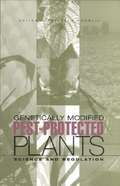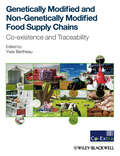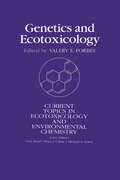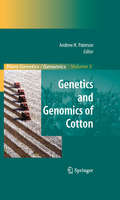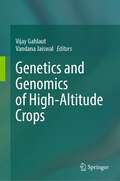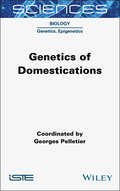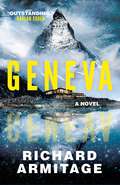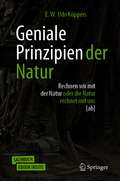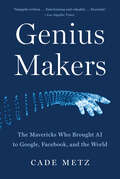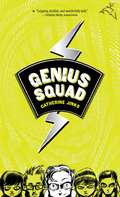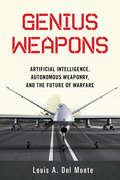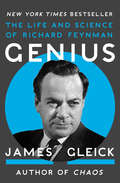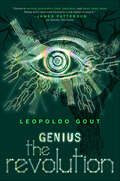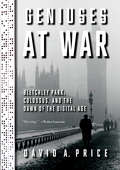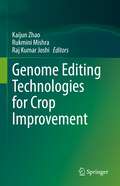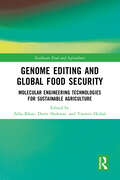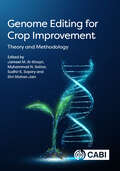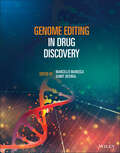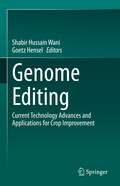- Table View
- List View
Genetically Modified Organisms, Grade 7: STEM Road Map for Middle School (STEM Road Map Curriculum Series)
by Carla C. Johnson Erin E. Peters-Burton Janet B. WaltonWhat if you could challenge your seventh graders to become informed citizens by analyzing real-world implications of GMOs? With this volume in the STEM Road Map Curriculum Series, you can! Genetically Modified Organisms outlines a journey that will steer your students toward authentic problem solving while grounding them in integrated STEM disciplines. Like the other volumes in the series, this book is designed to meet the growing need to infuse real-world learning into K–12 classrooms. This interdisciplinary, five-lesson module uses project- and problem-based learning to help students investigate the opportunities and challenges of GMO production and consumption. Working in teams, students will create a documentary communicating the health, social, and economic aspects of GMO production and consumption. To support this goal, students will do the following: • Use the Internet and other sources to build knowledge of an issue, and recognize and value stakeholders and their viewpoints in an issue. • Explore the relationship among local, state, and federal legislation related to GMOs. • Understand the role of cost-benefit analysis in making informed economic decisions. • Develop skills to evaluate arguments, create and communicate individual understanding and perspectives. • Gain a deeper understanding that structure and function are related by examining plants and how the environment and genetics influences structure. • Gain a better understanding of what tools humans have developed to genetically alter organisms for human benefit. The STEM Road Map Curriculum Series is anchored in the Next Generation Science Standards, the Common Core State Standards, and the Framework for 21st Century Learning. In-depth and flexible, Genetically Modified Organisms can be used as a whole unit or in part to meet the needs of districts, schools, and teachers who are charting a course toward an integrated STEM approach.
Genetically Modified Pest-protected Plants: Science And Regulation
by National Research CouncilThis book explores the risks and benefits of crops that are genetically modified for pest resistance, the urgency of establishing an appropriate regulatory framework for these products, and the importance of public understanding of the issues.The committee critically reviews federal policies toward transgenic products, the 1986 coordinated framework among the key federal agencies in the field, and rules proposed by the Environmental Protection Agency for regulation of plant pesticides. This book provides detailed analyses of: Mechanisms and results of genetic engineering compared to conventional breeding for pest resistance. Review of scientific issues associated with transgenic pest-protected plants, such as allergenicity, impact on nontarget plants, evolution of the pest species, and other concerns. Overview of regulatory framework and its use of scientific information with suggestions for improvements.
Genetically Modified and non-Genetically Modified Food Supply Chains: Co-Existence and Traceability
by Yves Bertheau John DavisonIn the European Union nations, and other countries including Japan, Australia and Malaysia, it is a legal requirement that food products containing genetically modified organism (GMO) materials are labelled as such in order that customers may make informed purchasing decisions. For manufacturers and consumers to be confident about these assertions, systems must be in place along the entire food chain which support the co-existence of GM and non GM materials whilst maintaining a strict segregation between the two. This book is an output of a European Union-funded project entitled "Co-Extra: GM and non-GM food and feed supply chains: their Co-Existence and Traceability". The objective of this four year project is to provide practical tools and methods for implementing co-existence that will: enable the co-existence of genetically modified (GM) and non-GM crops enable the segregation and tracing of genetically modified organism (GMO) materials and derived products along the food and feed chains anticipate the future expansion of the use of GMOs The project is designed to foster a robustly science-based debate amongst all of the stakeholders involved in the food and feed chains, and the tools will be assessed not only from a technical point of view but with regard to the economic and legal aspects. It also surveys the GMO-related legal regimes and practices that exist in and beyond the EU. This book examines the practical tools and methods available to implement the co-existence and traceability of GM and non-GM food materials along the entire food and feed chains, as demanded by consumers and by legislation in force in the EU and elsewhere. GM and Non-GM Supply Foods is a source of valuable information for food manufacturers, food research institutions and regulatory bodies internationally.
Genetics And Ecotoxicology
by Valery E. ForbesThis first volume in the series provides a detailed treatment in ecotoxicology and stresses why genetics is important in understanding if and how chemical contaminants affect populations. Written by an array of international contributors from various fields covering mammals, invertebrates, fish, plants, as well as molecular ecotoxicology, this book considers both ecological/evolutionary consequences and practical implications of the interplay between chemical toxicants and the genetic population.In broadening the understanding of ecological response, this resource ranges from molecular to classical genetics, from plant to animal, from asexual to sexual, touching on some fundamental issues of evolutionary biology. In addition, gaps in our present understanding of genetic and ecotoxicological processes and future research directions have been identified.
Genetics and Genomics of Cotton
by Andrew H. PatersonThe Gossypium (cotton) genus presents novel opportunities to advance our understanding of the natural world and its organic evolution. In this book, advances of the past decade are summarized and synthesized to elucidate the current state of knowledge of the structure, function, and evolution of the Gossypium genome, and progress in the application of this knowledge to cotton improvement. This book provides the first comprehensive reference on cotton genomics.
Genetics and Genomics of High-Altitude Crops
by Vijay Gahlaut Vandana JaiswalThis edited book provides comprehensive coverage of the recent advances in genetics and genomics of high-altitude crops (HACs). This book also assists in understanding the genomic adaptation to the environmental extremes at high altitude conditions. High-altitude crops are challenged by several high-altitude specific environmental stresses, i.e., extensive UV-B irradiation, extremely low temperature and intense hypoxia. These environmental constraints would be expected to cause genomic variations in HACs. Several studies have been conducted to dissect genetic and genomic regions in HACs to cope up with environmental stresses. However, these types of studies were not compiled or summarized anywhere. This book is of interest to teachers, researchers, climate change scientists, capacity builders and policymakers. Also, the book serves as a valuable resource for undergraduate and graduate students of agriculture, crop biotechnology, and environmental sciences. Scientists and policymakers who are working on high-altitude crops will also find this to be a useful read.
Genetics of Domestications (ISTE Invoiced)
by Georges PelletierThe domestication of plants, animals and microorganisms has enabled the development of agriculture, animal husbandry, the processing of their products and, ultimately, civilizations. The species concerned by domestication, the regions of the world where it could take place, the clues that enable us to identify wild ancestors, the particularly morphological or physiological properties that characterize it, the modified genes, the genetic exchanges that domesticated organisms maintained with their wild ancestors, and the consequences of the structuring of the species that resulted in animal breeds or plant varieties, are all questions that develop studies in the fields of archaeology, sociology, ecology and genetics. Genetics of Domestications deals with the contribution of modern methods of genetic analysis and genomics to historical knowledge of domestications, their nature and diversity, based on examples of twelve species or groups of species.
Genetics of Salt Tolerance in Plants: A Central Dogma Perspective and Strategies for Enhancement
by Kehinde A. Adeboye Victor J. Bamisaye Farwa Basit Usman Rabi’u Bello Javaid Akhter Bhat Jamindar Buddiga Utpal Das Balasundari Dharbaranyam Xianzhong Feng M. Gayathri Abubakar Mohammad Gumi Md Sazzad Hossain Emmanuel O. Idehen Krishnananda P. Ingle Nancy McMulkin Mushtaq Ahmad Najar Oyeboade A. Oyetunde Kapil Patil Britta Pitann Shiva Sai Prasad Fergie Ann Quilloy Md Zillur Rahman J. R. Rajeshwar P. W. Ramteke Hamza Ramzan Vincent Pamugas Reyes Kausalya Sakthivel Palanisamy Senthilmurugan Usama Sheraz Sajid Shokat Pradeep Kumar Shukla Atul Singh Gayatri Venkataraman Mst Ishrat ZahanGene expression in cells follows a prescribed pathway that conforms to the Central Dogma; where the genetic information stored in DNA is transcribed into RNA and then expressed into proteins, which influences most plant traits. Plant salt tolerance research is directed towards identifying nucleotide variants that could contribute to tolerant phenotypes. This book comprehensively presents the current state of knowledge on plant salt tolerance through meticulous analysis of the processes operating across the Central Dogma. It provides a detailed account of modulation of gene expression through genome editing systems to achieve crop improvement against salt stress. It also provides state-of-the-art information on advances in breeding technologies of genome selection and accelerated de novo domestication for rapidly improving the salt tolerance of plants for global food security. This book: 1.Provides a comprehensive coverage of plant salt tolerance mechanisms. 2.Spotlights various factors functioning along the Central Dogma pathway and their regulation in response to salinity. 3.Examines how these factors function to protect the plants from high salinity. 4.Highlights advances in cutting-edge breeding technologies for improving salt tolerance. The book will be of particular value to students and researchers of plant genetics, molecular biology and physiology and those with an interest in salinity and salt tolerance.
Genetics, Biofuels and Local Farming Systems
by Eric LichtfouseSustainable agriculture is a rapidly growing field aiming at producing food and energy in a sustainable way for our children. This discipline addresses current issues such as climate change, increasing food and fuel prices, starvation, obesity, water pollution, soil erosion, fertility loss, pest control and biodiversity depletion. Novel solutions are proposed based on integrated knowledge from agronomy, soil science, molecular biology, chemistry, toxicology, ecology, economy, philosophy and social sciences. As actual society issues are now intertwined, sustainable agriculture will bring solutions to build a safer world. This book series analyzes current agricultural issues and proposes alternative solutions, consequently helping all scientists, decision-makers, professors, farmers and politicians wishing to build safe agriculture, energy and food systems for future generations.
Geneva: A Novel
by Richard ArmitageA bold and unpredictable debut thriller set in the biotech world (and deceptive beauty) of Switzerland, by acclaimed actor Richard Armitage.Nobel Prize-winning scientist Sarah Collier has taken a step back from work to spend more time with her family. Movie nights with her husband Daniel and their daughter Maddie are a welcome respite from the scrutiny of the world&’s press. As much as it hurts, it&’s good to be able to see her father more too. He&’s suffering from Alzheimer&’s and needs special care. Sarah has started to show tell-tale signs of the disease too. She&’s been experiencing blackouts and memory loss. It&’s early days but she must face the possibility that she won&’t be there to see her daughter grow up. Daniel, a neuroscientist himself, is doing his best to be supportive but she already knows that she will have to be the strong one. For all of them. So when Sarah is invited to be the guest of honour at a prestigious biotech conference in Geneva she declines, wanting to stay out of the public eye—that is until Daniel shows her the kind of work that the enigmatic Mauritz Schiller has been developing. Flown first class to the spectacular alpine city and housed in a luxury hotel, Sarah and Daniel are thrust back into the spotlight. As they try to shut out the noise of the public media storm, in private Sarah is struggling with her escalating symptoms. And the true extent of what Schiller has achieved is a revelation. This is technology that could change medicine forever. More than that, it could save Sarah&’s life. But technology so valuable attracts all kinds of interest. Wealthy investors are circling, controversial blogger Terri Landau is all over the story, and someone close to Schiller seems bent on taking advantage of the situation for themselves. Sarah feels threatened and does not know who to trust—including herself. Far from being her lifeline Schiller's technology may be her undoing. As events spiral out of control, Sarah and Daniel are faced with the ultimate question: how far would you go for someone you love?
Geniale Prinzipien der Natur: Rechnen wir mit der Natur oder die Natur rechnet mit uns [ab]
by E. W. KüppersDieser Band legt den Schwerpunkt auf praktische Anwendungen der Prinzipien, die aus der Natur in unserem Gestaltungsraum übertragen werden können. Er ist dabei getragen von den Regelungs- und Steuerungssystemen, wie sie die Wissenschaft der Kybernetik beschreibt.
Genius Makers: The Mavericks Who Brought AI to Google, Facebook, and the World
by Cade Metz<P><P>THE UNTOLD TECH STORY OF OUR TIME <P><P> What does it mean to be smart? To be human? What do we really want from life and the intelligence we have, or might create? With deep and exclusive reporting, across hundreds of interviews, New York Times Silicon Valley journalist Cade Metz brings you into the rooms where these questions are being answered. Where an extraordinarily powerful new artificial intelligence has been built into our biggest companies, our social discourse, and our daily lives, with few of us even noticing. Long dismissed as a technology of the distant future, artificial intelligence was a project consigned to the fringes of the scientific community. <P><P> Then two researchers changed everything. One was a sixty-four-year-old computer science professor who didn’t drive and didn’t fly because he could no longer sit down—but still made his way across North America for the moment that would define a new age of technology. The other was a thirty-six-year-old neuroscientist and chess prodigy who laid claim to being the greatest game player of all time before vowing to build a machine that could do anything the human brain could do. They took two very different paths to that lofty goal, and they disagreed on how quickly it would arrive. But both were soon drawn into the heart of the tech industry. Their ideas drove a new kind of arms race, spanning Google, Microsoft, Facebook, and OpenAI, a new lab founded by Silicon Valley kingpin Elon Musk. But some believed that China would beat them all to the finish line. <P><P> Genius Makers dramatically presents the fierce conflict between national interests, shareholder value, the pursuit of scientific knowledge, and the very human concerns about privacy, security, bias, and prejudice. Like a great Victorian novel, this world of eccentric, brilliant, often unimaginably yet suddenly wealthy characters draws you into the most profound moral questions we can ask. And like a great mystery, it presents the story and facts that lead to a core, vital question: How far will we let it go?
Genius Squad
by Catherine JinksNow that the Axis Institute for World Domination has been blown up; the founder, Dr. Phineas Darkkon, has died; and Prosper English (who enrolled Cadel in the first place) is in jail for myriad offenses, Cadel Piggott has round-the-clock surveillance so he'll be safe until he testifies against Prosper English. But nobody seems to want Cadel. Not Fiona, his social worker; not Saul Greeniaus, the detective assigned to protect him. When he is approached by the head of Genius Squad--a group formed to investigate GenoME, one of Darkkon's pet projects--Cadel is dubious Genius Squad can offer him a real home and all the technology his heart desires. But why can't he bring himself to tell Saul what the group is really up to? And how can Genius Squad protect Cadel once Prosper English breaks out of jail?
Genius Weapons: Artificial Intelligence, Autonomous Weaponry, and the Future of Warfare
by Louis A. Del MonteA technology expert describes the ever-increasing role of artificial intelligence in weapons development, the ethical dilemmas these weapons pose, and the potential threat to humanity.Artificial intelligence is playing an ever-increasing role in military weapon systems. Going beyond the bomb-carrying drones used in the Afghan war, the Pentagon is now in a race with China and Russia to develop "lethal autonomous weapon systems" (LAWS). In this eye-opening overview, a physicist, technology expert, and former Honeywell executive examines the advantages and the potential threats to humanity resulting from the deployment of completely autonomous weapon systems. Stressing the likelihood that these weapons will be available in the coming decades, the author raises key questions about how the world will be impacted. Though using robotic systems might lessen military casualties in a conflict, one major concern is: Should we allow machines to make life-and-death decisions in battle? Other areas of concern include the following: Who would be accountable for the actions of completely autonomous weapons--the programmer, the machine itself, or the country that deploys LAWS? When warfare becomes just a matter of technology, will war become more probable, edging humanity closer to annihilation? What if AI technology reaches a "singularity level" so that our weapons are controlled by an intelligence exceeding human intelligence?Using vivid scenarios that immerse the reader in the ethical dilemmas and existential threats posed by lethal autonomous weapon systems, the book reveals that the dystopian visions of such movies as The Terminator and I, Robot may become a frightening reality in the near future. The author concludes with concrete recommendations, founded in historical precedent, to control this new arms race.
Genius: The Life and Science of Richard Feynman
by James GleickNew York Times Bestseller: This life story of the quirky physicist is &“a thorough and masterful portrait of one of the great minds of the century&” (The New York Review of Books). Raised in Depression-era Rockaway Beach, physicist Richard Feynman was irreverent, eccentric, and childishly enthusiastic—a new kind of scientist in a field that was in its infancy. His quick mastery of quantum mechanics earned him a place at Los Alamos working on the Manhattan Project under J. Robert Oppenheimer, where the giddy young man held his own among the nation&’s greatest minds. There, Feynman turned theory into practice, culminating in the Trinity test, on July 16, 1945, when the Atomic Age was born. He was only twenty-seven. And he was just getting started. In this sweeping biography, James Gleick captures the forceful personality of a great man, integrating Feynman&’s work and life in a way that is accessible to laymen and fascinating for the scientists who follow in his footsteps.
Genius: The Revolution
by Leopoldo GoutThree teen geniuses from diverse backgrounds must take down an online terrorist ring, rescue an imprisoned father, and prepare for their final showdown with a misguided mastermind in this third and final book in the Genius YA trilogy by Leopoldo Gout.How do we stop him? We beat him at his own game. Painted Wolf: Mysterious activist blogger and strategist from China. Faces off against dangerous online terrorists in an attempt to free her father from prison. Tunde: Fourteen-year-old engineering genius. Liberated his Nigerian village from a vicious warlord only to discover a much more dangerous threat. Rex: Sixteen-year-old Mexican-American programmer and hacker. Bands together with his friends and long lost brother to stop a mastermind from destroying the internet. The Revolution: Outwit evil organizations. Expose the truth. Rescue their families. Save the world. If we work together, we can change the world. “Genius is exciting, provocative, fresh, innovative, and smart, smart, smart. Please don’t wait until Genius is a cult classic to read it.” —James Patterson on Genius: The Game
Geniuses at War: Bletchley Park, Colossus, and the Dawn of the Digital Age
by David A. PriceThe dramatic, untold story of the brilliant team whose feats of innovation and engineering created the world&’s first digital electronic computer—decrypting the Nazis&’ toughest code, helping bring an end to WWII, and ushering in the information age.Planning the invasion of Normandy, the Allies knew that decoding the communications of the Nazi high command was imperative for its success. But standing in their way was an encryption machine they called Tunny (British English for &“tuna&”), which was vastly more difficult to crack than the infamous Enigma cipher. To surmount this seemingly impossible challenge, Alan Turing, the Enigma codebreaker, brought in a maverick English working-class engineer named Tommy Flowers who devised the ingenious, daring, and controversial plan to build a machine that would calculate at breathtaking speed and break the code in nearly real time. Together with the pioneering mathematician Max Newman, Flowers and his team produced—against the odds, the clock, and a resistant leadership—Colossus, the world&’s first digital electronic computer, the machine that would help bring the war to an end. Drawing upon recently declassified sources, David A. Price&’s Geniuses at War tells, for the first time, the full mesmerizing story of the great minds behind Colossus and chronicles the remarkable feats of engineering genius that marked the dawn of the digital age.
Genome Editing Technologies for Crop Improvement
by Kaijun Zhao Rukmini Mishra Raj Kumar JoshiThis book compiles the relevant information related to genome editing tools and their roles in crop improvement. The book contains a brief introduction about various genome editing tools and their application in major crops. It discusses the genome editing approaches and the strategies used for genome editing in different crops. Some of the chapters cover the detailed methodology of sgRNA design, vector construction and transformation in different crops followed by data analysis. A few chapters focus on the applications of genome editing tools towards crop improvement. This book will be of particular interest to plant biologists working in the field of genome editing and crop breeders. It will provide valuable information and useful material for our readers’ experimental work.
Genome Editing and Global Food Security: Molecular Engineering Technologies for Sustainable Agriculture (Earthscan Food and Agriculture)
by Zeba Khan Durre Shahwar Yasmin HeikalWith the rapid increase in the global population and changing climatic impacts on agriculture, this book demonstrates how genome editing will be an indispensable technique to overcome ongoing and prospective agricultural challenges. This book examines the role of genome editing in improving crop yields and contributing to global food security. It summarizes a range of genome editing techniques and discusses the roles they can play in producing a new generation of high-yielding, climate-ready crops. This includes site-specific nucleases, precision genome engineering, clustered regularly interspaced short palindromic repeats, and bioinformatics. It showcases how these gene editing techniques can tailor plants to not only increase yield-related traits but to also make them better suited to their environment and to be resistant to pests and extreme climatic events, such as droughts. The book also examines genome editing regulations and policies, the commercialization of genome-edited crops, and biosafety and biosecurity concerns. Overall, this book reveals and showcases how genome editing can improve crop resilience and production to address current and future agricultural challenges and alleviation of global food security concerns. This book will be of great interest to students and scholars of agricultural science, crop and plant science, genome editing, sustainable agriculture, biotechnology, and food security.
Genome Editing for Crop Improvement: Theory and Methodology
by Shri Mohan Jain Jameel M. Al-Khayri Muhammad N. Sattar Sudhir K. SoporyGenome editing offers a powerful tool to significantly accelerate crop-breeding programs in order to develop new and improved varieties. It allows precise modification of an organism's DNA sequence, often by creating targeted double-strand breaks at specific locations. The CRISPR-Cas system has emerged as the preferred method of gene editing and offers a powerful technology for crop improvement. The use of CRISPR in plant research has led to significant improvements in crop performance in terms of yield, nutrition, stress tolerance and resistance against agricultural pests and diseases. This book explores the cutting-edge field of genome editing, its applications and potential to revolutionize the genetic improvement of crops. It includes: Foundational concepts and historical context of genome editing (GE). Structure and mechanisms of various genome editing techniques. Application of GE for trait improvements in plants. Regulatory, biosafety, and ethical considerations. This is a valuable resource for researchers in crop genetic improvement, graduate and postgraduate students in molecular biology and biotechnology programs, and professionals in the field.
Genome Editing in Drug Discovery
by Sumit Deswal Marcello MarescaGENOME EDITING IN DRUG DISCOVERY A practical guide for researchers and professionals applying genome editing techniques to drug discovery In Genome Editing in Drug Discovery, a team of distinguished biologists delivers a comprehensive exploration of genome editing in the drug discovery process, with coverage of the technology’s history, current issues and techniques, and future perspectives and research directions. The book discusses techniques for disease modeling, target identification with CRISPR, safety studies, therapeutic editing, and intellectual property issues. The safety and efficacy of drugs and new target discovery, as well as next-generation therapeutics are also presented. Offering practical suggestions for practitioners and academicians involved in drug discovery, Genome Editing in Drug Discovery is a fulsome treatment of a technology that has become part of nearly every early step in the drug discovery pipeline. Selected contributions also include: A thorough introduction to the applications of CRISPRi and CRISPRa in drug discovery Comprehensive explorations of genome-editing applications in stem cell engineering and regenerative medicine Practical discussions of the safety aspects of genome editing with respect to immunogenicity and the specificity of CRISPR-Cas9 gene editing In-depth examinations of critical socio-economic and bioethical challenges in the CRISPR-Cas9 patent landscape Perfect for academic researchers and professionals in the biotech and pharmaceutical industries, Genome Editing in Drug Discovery will also earn a place in the libraries of medicinal chemists, biochemists, and molecular biologists.
Genome Editing: Current Technology Advances and Applications for Crop Improvement
by Shabir Hussain Wani Goetz HenselOver the last few decades, various techniques have been developed to alter the properties of plants and animals. While the targeted transfer of recombinant DNA into crop plants remains a valuable tool to achieve a desirable breeding outcome, integration of transgenes into the host genome has been random, which in part, leads to reduced acceptance of GMOs by the general population in some parts of the world. Likewise, methods of induced mutagenesis, such as TILLING, have the disadvantage that many mutations are induced per plant, which has to be removed again by expensive backcrossing. Advances in genome sequencing have provided more and more information on differences between susceptible and resistant varieties, which can now be directly targeted and modified using CRISPR/Cas9 technology. By selecting specific gRNAs occurrence of off-target modifications are comparatively low. ZFNs and TALENs- based approaches required re-engineering a new set of assembled polypeptides for every new target site for each experiment. The difficulty in cloning and protein engineering prevented these tools from being broadly adopted by the scientific community. Compared to these technologies, designing the CRISPR toolbox is much simpler and more flexible. CRISPR/Cas9 is versatile, less expensive and highly efficient. It has become the most widely used technology for genome editing in many organisms.Since its inception as a powerful genome-editing tool in late 2012, this breakthrough technology has completely changed how science is performed. The first few chapters in this book introduce the basic concept, design and implementation of CRISPR/Cas9 for different plant systems. They are followed by in-depth discussions on the legal and bio-safety issues accompanying commercialization and patenting of this emerging technology. Lastly, this book covers emerging areas of new tools and potential applications. We believe readers, novice and expert alike, will benefit from this all-in-one resource on genome editing for crop improvement.Chapter 17 is available open access under a Creative Commons Attribution 4.0 International License via link.springer.com.
Genome Engineering for Crop Improvement (Concepts and Strategies in Plant Sciences)
by Bidyut Kumar Sarmah Basanta Kumar BorahThis book serves the teachers, researchers and the students as a handy and concise reference as well as guidebook while designing and planning for use of the advanced technologies for crop improvement.The content of the book is designed to cover the latest genome engineering techniques for crop improvement. The conventional breeding has got its limitations such as non-availability of desired genes within the genepool. In many cases, breeding has been highly used and it has nearly reached its highest limit so far as the productivity and production of crops are concerned. However, with increasing need of food and decreasing resources, including water, land, labour, etc., to feed the growing population, the alternative available ways of increasing crop productivity need to be explored and exploited. Genome engineering has a wide scope that includes technologies such as genetic engineering and transgenesis, RNA technologies, CRISPR, cisgenics and subgenics for better productivity and more efficient biotic and abiotic stress management. Therefore, the book is planned to enlighten the readers with the advanced technologies with examples and case studies, whenever possible. Efforts will be made to emphasize on general efforts on various major food crops; however, it would also be made clear that such efforts could be taken as proofs of concepts and that this could be extrapolated keeping the demand in mind.
Genome and Epigenome Editing for Stress-Tolerant Crops
by Jen-Tsung ChenProvides a timely overview of the use of CRISPR and non-coding RNA technologies to develop climate-resilient crops With mounting challenges from climate change, expanding populations, and resource limitations, the need for resilient and sustainable agricultural systems has never been greater. Genome and Epigenome Editing for Stress-Tolerant Crops summarizes advanced techniques for creating crops that can withstand both biotic and abiotic stressors. Edited by renowned biologist Jen-Tsung Chen, this authoritative volume discusses the coordination of CRISPR/Cas technology with ncRNA-based epigenetics to enhance stress tolerance and improve crop quality. In addition to offering insights into genetic and molecular advances, contributions by experts in the field present key methodologies and applications that bridge multiple omics technologies with genome editing for impactful agricultural outcomes. Addressing emerging tools and strategies that could be instrumental in achieving the United Nations Sustainable Development Goals (SDGs) and advancing sustainable agriculture, Genome and Epigenome Editing for Stress-Tolerant Crops: Provides an in-depth overview of CRISPR/Cas and non-coding RNA strategies to develop stress-tolerant crops.Integrates multiple omics approaches, including genomics, transcriptomics, and metabolomics for comprehensive crop improvement.Discusses strategies for resilience against both abiotic and biotic stressors, such as drought, salinity, pests, and pathogens.Offers practical applications of CRISPR and RNA technologies for high-yield, high-quality crop development.Presents recent research advancements in epigenetic regulation to fine-tune plant stress responses.Discusses future directions in plant science to inspire new research and experimental designs. Genome and Epigenome Editing for Stress-Tolerant Crops is essential reading for advanced undergraduate and graduate courses in plant biology, molecular genetics, and agricultural biotechnology. It is also a valuable reference for researchers, plant breeders, and scientists working on crop improvement and climate-resilient agriculture initiatives.
Genome and Genomics: From Archaea to Eukaryotes
by K. V. ChaitanyaThis book provides a detailed and up-to-dated information on the genomes belonging to three major life forms on Earth – archaea, prokaryotes and eukaryotes. Each section describes about the genome of a specific group of organisms, such as viruses, archaea, bacteria, eukaryotes and organellar genomes. Individual chapters provide details of their organization, structure, evolution, sequencing strategies and functions. Further, this book discusses the technologies that are applied for genome sequencing; assembly, annotation and gene prediction. Other topics include the genomes of important model organisms, mitochondria genome of Neanderthal fossil, etc. This book also examines the evolution of chloroplast and mitochondria genomes by comparing with bacteria, addresses the diseases that occur in humans due to the mutations in mitochondrial genome, gene therapy and engineering of chloroplast and mitochondrial genomes. Lastly, it features an overview of the role of proteomics, exposomics, connectomics, metabolomics, and microbiomics. This book is a fascinating read for students, lecturers and researchers in the field of genetics, genomics, microbiology and life sciences.

